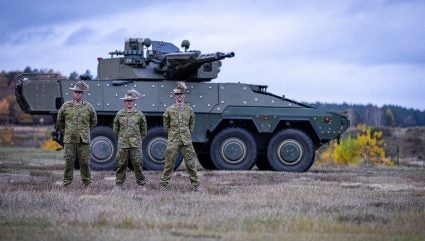
The Australian Defence Force revealed that ahead of the delivery of more Boxer reconnaissance vehicles, three soldiers from the 2nd/14th Light Horse Regiment (LHR) contributed to the platform’s design late in 2023.
Between 2019 and 2021, the Army inducted 25 Boxer vehicles as part of its Block I order to provide an interim cavalry. The delivery of the remaining 186 Block II vehicles will begin this year, leveraging the experience of operators of the Block I vehicles.
Trials were held in Unterluss, Germany and included firing the MK30-2 cannon and MAG58 machine gun in extreme weather conditions, as well as testing the new programmable munitions capability.
Tests included firing the MK30-2 cannon and MAG58 machine gun in extreme weather conditions, as well as testing the new programmable munitions capability.
Crew commander Lance Corporal Ben Crawford and driver Trooper Liam Skinner fired 30-millimetre training and programmable rounds from the cannon in the Block II turret.
The visit included a brief on the Block II vehicle design, operation of the combat intelligence, surveillance and reconnaissance system and new weapon control systems.

US Tariffs are shifting - will you react or anticipate?
Don’t let policy changes catch you off guard. Stay proactive with real-time data and expert analysis.
By GlobalDataBoxer development
The Boxer MIV is an 8×8 multi-purpose armoured vehicle managed by the European armaments agency, the Organisation for Joint Armament Co-operation (OCCAR). The vehicle can operate in both high-intensity conflicts as well as in relief and humanitarian operations.
While it is manufactured by Rheinmetall in Hamburg, Germany the Australian workforce involved in the construction of the vehicles will be used to support sustainment, progressive development and upgrades to the Boxer. They will also be used to support potential export opportunities.
Some variants of the vehicle will be equipped with an anti-tank guided missile and a remote weapon station – Block I (Kongsberg) and Block II (Electro Optic Systems).
Production of the Boxer is also facilitated by OCCAR. Australia joined as an ‘observer state,’ where in formation and lessons learned by the participating nations will be shared with the commonwealth.
A co-operative relationship between all user nations will persist throughout the vehicle’s lifecycle via OCCAR since the customers will be able to share spares and components of the interoperable platform.
In fact, it was recently announced that the UK will need to concede “temporary concessions” for a mix of Boxer components during the next year or two. This will involve approaching fellow OCCAR participants in the Boxer programme – Germany, Lithuania and the Netherlands – for their spares parts that can be used for the UK Boxers as the nation waits for its own supply chain to deliver.
Block II is more soldier-centric
Trooper Skinner was impressed with the strong focus on crew safety:
“The implementation of an emergency escape hatch for the driver on the Block II design ensures improved survivability. Seeing lessons learned from Block I now being implemented into Block II provided me with confidence moving forward.”
Soldiers participated in a working group with Rheinmetall in Kassel to support future design options for Boxer with an active protection system.
They were also briefed on the ballistic and blast testing program in Germany and Australia.
“I found it incredibly beneficial to see the input that soldiers from 2/14 LHR have made to the design of Block II Boxer, particularly in the crew operation of the weapon systems, and be able to tell them how it has been implemented,” Crawford stated.



